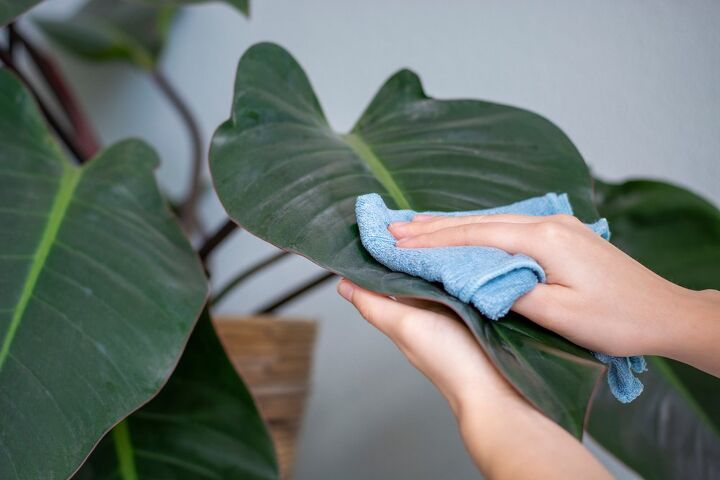What To Do When Your Indoor Plants Collect Dust

Indoor plants are a fantastic way to bring color, life, and even oxygen into an indoor space. They help cleanse the air and give a natural feel to an otherwise man-made space. Often, indoor plants require very little maintenance and need water once a week or even less. But from time to time, just like with any item in your home, indoor plants get dusty. This can give your otherwise green and vibrant indoor plant a dull and dirty look. But what do you do when your indoor plants start to collect dust?
When your indoor plants collect dust, clean them, as dust can affect the plant’s health and ability to grow. Bring the plant outside in the rain, or spray it carefully with your garden hose. You can use a hand spray bottle to clean leaves or a damp cloth. For small plants, you can even submerge them in water, or if the plant can’t get wet, use a clean duster.
If you noticed dust on one or several of your indoor plants, then it is important you address the situation right away. The longer you let dust collect on an indoor plant, the more likely it is that something negative can happen to it. But not all plants can be cleaned the same way. Keep reading to learn the most effective ways to clean dust off indoor plants, as well as how to help prevent them from collecting dust in the future.
Six Ways To Remove Dust From Your Indoor Plants
1. Use Spray Feature On Your Garden Hose
One of the best, quickest, and easiest way to get dust off your indoor plant is to bring it outside. If you have a backyard and a garden hose with a shower nozzle attachment, then this method might be perfect for you.
If your indoor plant is easy to move, bring it outside and onto the grass. Use the shower or mist option, and spray the plant at an angle, from various angles. This will not only get the layer of dust off the plant ,but it will also give it a quality watering. Just remember to leave it out in the sun for a bit. This will give the plant some sun and also allow the leaves to dry. You don’t want to bring the plant in when the leaves are wet, as this can promote mold growth.
2. Use A Squirt Bottle or Shower Attachment Over The Sink
If you don’t have a backyard, or a hose, or it is a pain to move your plant outside, then consider bringing it over to the sink. If you have a shower nozzle attachment to your sink, you can use this to strategically wash away dust from the plant.
Your sink can provide similar cleaning benefits to your outdoor hose, just on a smaller scale. Use the shower nozzle to trace the entire length of the dusty leaves and branches. Allow the plant to drip dry, and also wipe the leaves with a clean towel or paper towel after most of the water has dripped away. This will prevent mold and also stop you from tracking water through the house.
3. Wipe The Leaves With A Damp Cloth
Some indoor plants are either too heavy or incredibly inconvenient to move. If you have a plant that can’t be moved to the kitchen sink or outdoors, then consider using a clean damp cloth. Take it and carefully wipe each leaf and the stems of your dusty indoor plant.
This process is a bit more painstaking, as it takes more time and requires you to be careful not to break any leaves. But as long as you are patient and delicate, it is a highly effective way to remove dust from your plant. Just be sure that you take the time to constantly clean the cloth, so you are always wiping away dust with a clean cloth, not a dirty one.
4. Use A Clean Duster To Remove Hard To Reach Dust
Some plants have leaves and stems that shouldn’t get wet. These plants are often more susceptible to diseases and mold that thrive in moist conditions. If you have a plant like this, consider using a duster instead. Work your way from top to bottom on your plant. Carefully trace the big leaves, and don’t forget the stems as well.
Dusters don’t easily remove all the dust, but if you are diligent with your indoor plants, they should stay looking healthy and vibrant.
5. Put The Plant Outside When It Rains
If you live in a climate with reliable rain, then consider using this to your advantage. You can bring your dusty indoor plants outside just before it rains, and in many cases, nature will do the rest of the work for you.
A steady rain will soak the soil and clean off the plant as well. Best of all, rainwater is better for plants than tap water. This means you will be doing all sorts of favors for your indoor plants by bringing them outside when it rains.
6. Dunk Smaller Plants In A Water Bath
If you have smaller but resilient indoor plants, you can opt to dunk them in a large bowl of water. This is a very fast and highly effective way to remove dust from small indoor plants. The key to this method is to ensure you don’t lose the soil in the process of dunking the plant. It is best to dunk the plants when the soil is still moist, because doing when the soil is dry might cause the soil to fall out.
Why Dust Is Harmful To Your Indoor Plants
Dust Clogs A Plant’s Sun Receptors: When your indoor plant gets dusty, not only does it make the plants look less appealing, but it can actually harm the plant. This is because your indoor plant’s leaves are often its main receptors of sunlight. When you block these receptors, you are essentially preventing the plant from being able to obtain its food and nutrients. Cleaning its leaves is a great way to help your indoor plants grow.
Dirt And Dust Can Attract Some Bugs: Bugs can mean the demise of many plants. It is best to do all you can to prevent bugs from finding a home in your plants. Some bugs love dust, so keeping your plant free of dust is a great way to help keep the plant bug-free as well.
Over Time It Can Make Your Plants Susceptible to Disease: The longer you leave your plant dusty, the more susceptible it becomes to disease. This is because it will begin to lack nutrients, and won’t be as strong as it was when it was clean and dust-free.
Ways To Prevent Dust From Collecting On Your Indoor Plants
Keep Your Plant Away From HVAC Vents
Where you put your indoor plant can impact how much dust collects on it. Keeping your plant away from fans and HVAC vents, especially a return vent, is a great way to minimize the amount of dust your indoor plant will collect.
Get Your Plants Outside From Time To Time
Try and give your indoor plants some TLC once in a while. Give them natural light on a bright and breezy day, and rain on a rainy day. A day in the sun or an afternoon in the rain are both great ways to help your plant and keep it dust-free longer.
Clean The Leaves When You Water
If you don’t need to water your indoor plant often, then use this as an opportunity to clean your plant as well. If you use a duster or clean cloth method, it is much easier to clean a plant when it has little to no dust on it.
Summing Up What To Do When Indoor Plants Get Dusty
It is important to take immediate action when you notice dust on your indoor plants. You can bring your plants outside and hose them down with the shower nozzle. You can wash the plants in the sink, or use a clean damp cloth or duster to remove dust from the leaves. Keeping a plant's leaves clean is a great way for it to remain healthy and happy.
Related Guides:

Tom Gaffey is an expert writer who currently resides in Washington D.C. Tom has a passion for real estate and home improvement writing, as well as travel and lifestyle writing. He lived the last twelve years in Hawaii where he worked closely with luxury resorts and event planners, mastering his knowledge of aesthetics and luxury products. This is where he found his passion for home improvement and a keen interest in DIY projects. Currently, Tom resides in Washington D.C, and also working on his debut fiction novel.
More by Tom Gaffey




















![12 Washing Machine Brands to Avoid [with Recall Data]](https://cdn-fastly.upgradedhome.com/media/2023/07/31/9075781/12-washing-machine-brands-to-avoid-with-recall-data.jpg?size=350x220)


![10 Most Dangerous Neighborhoods in Baltimore [Updated]](https://cdn-fastly.upgradedhome.com/media/2023/07/31/9075655/10-most-dangerous-neighborhoods-in-baltimore-updated.jpg?size=350x220)



